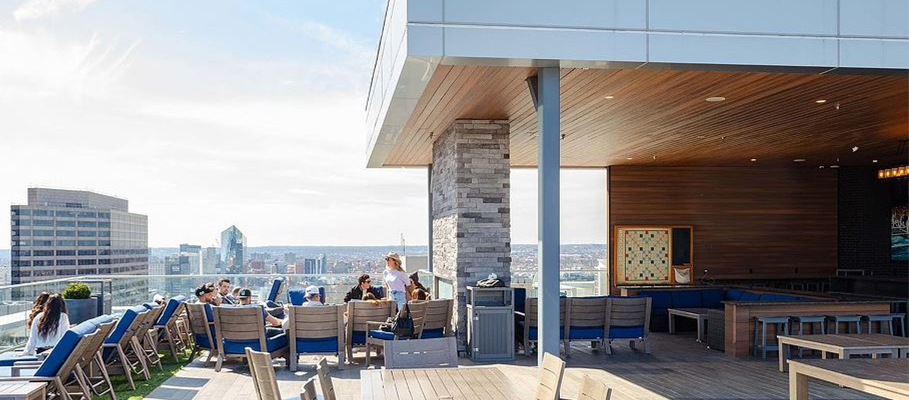The advent of the COVID-19 pandemic caused massive disruption to office work as usual. Companies that had been cautiously optimistic going into 2020 experienced dramatic upheaval just a few months in as stay-at-home orders transitioned to longer-lasting changes in where and how people work. Cities and municipalities worldwide continue to grapple with the question of how to handle office space sitting idle in formerly bustling central business districts.
In a recent NAIOP webinar, Gensler Principal Steven Paynter, OAA, ARB, explored the firm’s data-driven process for analyzing underused office spaces and determining how to transform them into vibrant and livable residential buildings.
At the end of 2019, Gensler had talked to their clients about their outlook on the year ahead and any concerns they had about the coming year. Many clients said their Class A office buildings had 1-2% vacancies; however, their Class B and Class C office buildings weren’t doing as well, even with upgrades and added amenities. In the chaos of the beginning of the COVID-19 pandemic, Gensler examined in depth how they could help to stabilize and rebuild their clients’ confidence in their portfolios and protect the value of their assets.
“A lot of developers we talked to said, ‘You can’t do these [office-to-residential] conversion projects. They don’t make sense. We tried them,’” Paynter said. “But at the same time, we were finishing buildings…that were working really well and were really viable and really popular.”
The office vacancy rate in almost every major market had been increasing since 2014 and 2015, especially in older buildings, Paynter said. It had been increasing slowly enough that people expressed continued optimism that the market would rebound; the pandemic changed that.
“[From 2019 through 2022], the vacancy rate has increased between 5-10% across almost every city in North America and that is set to get worse, from what we hear from our clients,” Paynter said. Companies have become more reluctant to sign long-term leases and the increase of hybrid and work-from-home policies has made companies reevaluate their office space use.
Headlines blare the coming default of $64 billion (or more) in CMBS loans this year, according to recent assessments. A lot of buildings are already going into default, Paynter said. Vacancies are highest in buildings built before 2008, with newer buildings performing much better, Paynter said.
One of the big tasks that Gensler has been working on with their clients is diversifying their portfolios, which have traditionally been around 70% office space, he said. They have also closely evaluated the “flight to quality” trend that accelerated in their Q4 2021 analysis. Gensler found that transit is the key factor for leasing Class C (the bottom 30%) office spaces. “If it’s one stop on transit, great; if it’s a train then a bus, or a train then a five-block walk, then they’re not interested,” Paynter said. “That puts a lot of buildings into a semi-unleasable category.”
High-quality, innovative tenants are generally taking better space than before with a focus on location, amenities and what will appeal to their office workers. So, they may be taking up smaller office space than pre-pandemic, but without spending less on rent overall, in order to attract and retain top talent.
Calgary Economic Development commissioned a study by Gensler to establish a development incentive program for the downtown, which had seen a steep increase in office vacancies that started even prior to the pandemic and landed upward of 30% by 2021. The city planned to remove 6 million square feet of office space over 10 years, providing $75 per square foot of incentives with the goal of regaining $16 billion of value in the real estate tax base. The first phase includes office-to-residential conversions with five major projects announced that will remove approximately 665,000 square feet of office space from downtown.
The Gensler team knew that it would not be time- or cost-effective to go building by building in determining which office buildings in downtown Calgary were viable candidates for residential conversions. Instead, Gensler compiled all existing information about the office buildings and turned them into blocks of data to create scoring criteria, with categories from the floor plate to the envelope. The team then compared each office building against the same data used for residential building designs, creating what they call a universal scorecard. Office buildings are very similar in general, as are most residential buildings, Paynter said, providing easier points of comparison. Gensler compared around 150 data points with certain characteristics weighted more heavily than others.
Location is, of course, a key factor in the viability of turning a particular office building into residential space. Does the site have good walkability, easy access to transit, nearby restaurants, grocery stores and more? When it comes to the floor plate and window-to-core distance, the algorithm determines whether a unit would be able to be divided into a unit of an appealing size and proportion. How many units would then be able to be carved out of the whole building? What is the parking situation, and does it meet the city’s requirements?
Gensler compiled hundreds of buildings in a data set and ran the calculations. The results were then compared to the ideal residential building, trying to gauge how closely the office building matched up to it on a bell curve. For an office-to-residential project to be viable, it should have 80% compatibility or above; any lower than 75% and the project becomes much less of a reasonable project to undertake.
When they began using the algorithm, the Gensler team tested it out using a sampling of real buildings to make sure the yield study reflected the viability of an office-to-residential conversion project. Their data has expanded to include major markets across the globe, as cities and municipalities worldwide seek to understand how to bring vibrancy – and jobs and tax revenue – back to their urban cores.
Featured image of Franklin Tower (Philadelphia) courtesy of Gensler. NAIOP webinars are presented by Majestic Realty. NAIOP members can listen to the full recording (available for 30 days) online.
Read more about the outlook for the office sector in Seismic Shift in Office: What’s Next featuring highlights from an elite gathering of C-suite office owners, investors and developers spearheaded by NAIOP.












